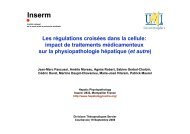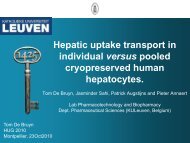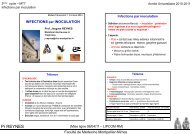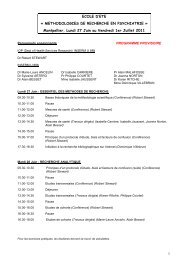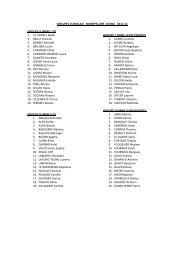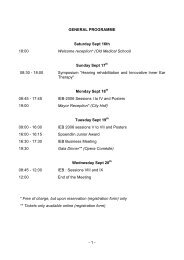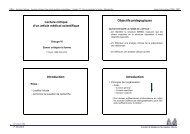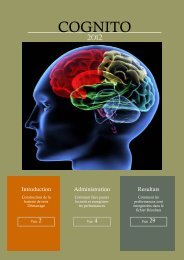COGNITO - Inserm
COGNITO - Inserm
COGNITO - Inserm
You also want an ePaper? Increase the reach of your titles
YUMPU automatically turns print PDFs into web optimized ePapers that Google loves.
Introduction<br />
<strong>COGNITO</strong> is a computerized neuropsychometric examination<br />
based on well-known cognitive tests designed for both<br />
cognition research and clinical assessment. It was originally<br />
developed with MacIntosh Hypercard software (version ECO)<br />
for use in both population and clinical studies of brain ageing<br />
and has now been up-dated into Flash, thus extending its<br />
hardware possibilities. The original version was used in a<br />
prospective population study from general practice from which<br />
normative data was derived, and the ability of the battery to<br />
detect difficulties in information processing two years prior to<br />
the diagnosis of dementia was also established. The battery has<br />
been subsequently used to track cognitive changes due to<br />
depression, following anesthesia, as a consequence of<br />
anticholinergic drug use, and in the development of diagnostic<br />
criteria for mild cognitive impairment (MCI). More recently<br />
<strong>COGNITO</strong> has been used to monitor cognitive changes during<br />
treatment in schizophrenia. <strong>COGNITO</strong> assesses reaction time,<br />
primary and working memory (an articulation sub-test further<br />
permitting identification of problems related to the articulatory<br />
loop) visuospatial and verbal secondary memory (with free,<br />
cued and multiple choice paradigms) , implicit learning<br />
(priming), language skills (word and syntax comprehension,<br />
naming, verbal fluency), functional and semantic<br />
categorization of visual data (visual reasoning and form<br />
perception), focused and divided attention (visual and auditory<br />
modalities) and crystallized intelligence (vocabulary).<br />
Responses are made via a tactile screen which permits the<br />
recording of response latency (deducting reaction time provides<br />
an estimation of information processing time). The<br />
examination may be carried out by trained lay interviewers<br />
with the possibility of the interviewer’s voice being replaced by<br />
pre-recorded instructions. The interpretation of the results can<br />
only, however, be made by a clinician competent in<br />
neuropsychology. Qualitative aspects of performance<br />
(perseveration, intrusions, visual field neglect) are also<br />
recorded. The test is suitable for children over 12 and adults of<br />
any age provided they are able to read, hear instructions and<br />
see the words and images. Practice trials are given which may<br />
be repeated until the subject has understood what is required.<br />
In order to be able to test highly performing persons some of<br />
the tasks become very challenging, so some tests stop<br />
automatically after repeated failures to avoid discouragement.<br />
The examination takes 45 minutes to an hour to complete<br />
depending on the ability of the subject. While it is possible to<br />
select and administer specific tests, it is suggested that the<br />
whole battery be given where possible in order to standardize<br />
fatigue effects and the time delay between the presentation of<br />
memory stimuli and the recall trials.<br />
2



